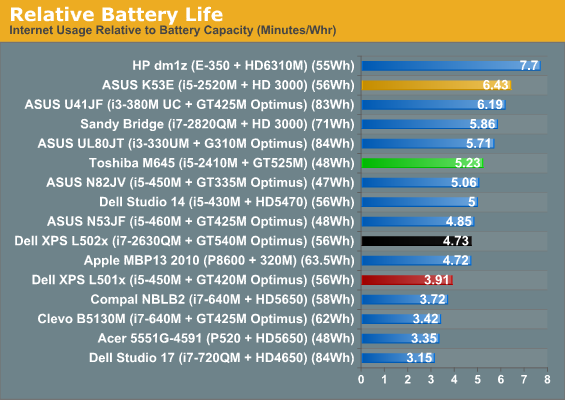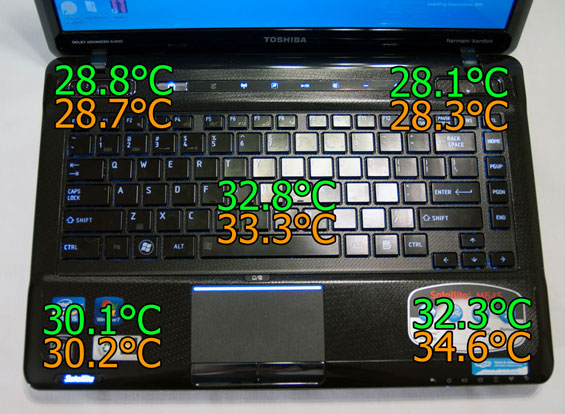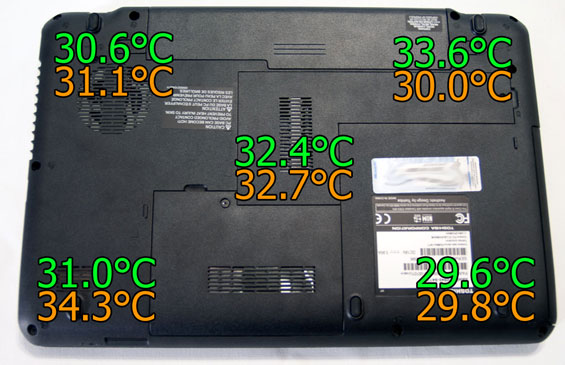Toshiba Satellite M645: The Steady March of Progress
by Dustin Sklavos on April 29, 2011 12:50 AM ESTThe Portability Sweet Spot
The 14-inch form factor is often the best place to find a compromise between weight, performance, and price. Dipping down to 13.3" can usually get similar hardware but the price begins to creep up and often GPU performance drops; going up to 15.6-inch can get you a lower price tag but more bulk. A notebook like Toshiba's Satellite M645 can really shine if it hits the right notes in portability and performance. We know the performance is largely there and the weight isn't too bad, so how's the battery life?




Battery life isn't great, but it's not dire either, and the M645 benefits from leveraging NVIDIA's Optimus technology. If there's a real weakness, it's in the mediocre battery the unit is saddled with; there aren't any other full-powered laptops with batteries this small that can still produce four hours of useful running time.
Heat and Noise
While typically we like to use HWMonitor to get a good look at the temperatures of the internals of our review units, in this instance even the most recent version was unable to track anything useful. The temperatures we can report put things into perspective a bit: the processor cores idled at around 46C, and under load bumped up to a still reasonable 77C. For a notebook processor, that's actually a pretty normal load temperature. The GeForce GT 525M did even better: it idled at 43C, and under load only scraped 66C. And finally, regardless of system load, the hard drive hung out at a relatively cool 38C. But it's when I look at those GPU temperatures that I start to feel a little cheated. Did Toshiba have to clock the chip down that badly? Let's see how that heat translates outside of the chassis.


It's by no means the coolest-running notebook, but it's actually not punishingly warm either. In my admittedly anecdotal experience with overclocking mobile graphics (and NVIDIA produces some fantastic little overclockers), raising core clocks doesn't usually produce that much more heat; it's when you start ramping the RAM up that temperatures go through the roof. I don't see any reason why the GT 525M couldn't have been run at spec in the M645; there's thermal headroom here and Optimus ensures the battery life wouldn't take the hit.
As far as noise goes, the fan does whirr up under load but it's not particularly offensive. You'll hear it, but the cooling system really does a fine job of keeping everything running at reasonable temperatures while preventing the fan from producing too much noise. All told, the M645 runs cool and quiet for a 14-inch notebook.










34 Comments
View All Comments
Icabus - Friday, April 29, 2011 - link
I don't know if I speak for everyone, but I would love to see 2 additional graphs. On the performance page a graph showing the current price, or price range for the other comparable offerings would be nice so you could see what kind of performance increase you are getting for the increase in price. I know this would not be easy as the price can very across the internet, and I understand price can change with rebates and sales all the time.The other graph is a little easier, but on the power usage page I would love to see the weight here. Since the different offerings come with different size batteries, it would be nice to see just how much of a difference there is between to offerings when on has a 4xWHr battery and another has a 8xWHr battery.
Chris Peredun - Friday, April 29, 2011 - link
"NVIDIA specifies the 525M to run the core at 600MHz (and thus the 96 CUDA cores at 1.2GHz), but Toshiba has substantially reduced its core clock to just 475MHz (reducing the CUDA cores to a paltry 950MHz). The cut is a brutal one that you'll see reduces performance below even a GeForce GT 420M."Thanks for highlighting this issue on page 1, Dustin.
In a dream world, NVIDIA would come kick them in the groin and tell them not to label or refer to the GPU in this unit as a "GT 525M" when it is *not obeying specs.*
Is there a particular reason we can't have that dream come true? I'm sure there's some country where a "false advertising" suit would land a hit.
Pessimism - Friday, April 29, 2011 - link
I'd love to see a "durability roundup" in which you take all the $699 budget wonder notebooks and put them through a series of impacts, drops, and spills followed by a photographed teardown detailing internal damage to see how these mass produced plastic consumer notebooks stand up to abuse.TegiriNenashi - Friday, April 29, 2011 - link
With processors, memory and the other stuff stagnated these days perhaps it makes sense for vendors to differentiate on their screen offering. Is it hard to comprehend how many users can't stand 16:9?jah1subs - Friday, April 29, 2011 - link
You can complain all you want about 16:9 and it will make absolutely no difference. Several years ago, I noticed a story on digitimes.com that said panel manufacturers realized that they could lay out more 16:9 panels than 16:10 panels in later generation manufacturing plants, perhaps 6th generation. The difference was 5% or 10%I have a question. For those who have seen 14" or 15.6" panels, is 1600x900 more or less readable than 1366x768, all other things being equal (ceteris paribus)?
P.S. ceteris paribus is correctly spelled. I searched it before posting the message.
kmmatney - Friday, April 29, 2011 - link
"I have a question. For those who have seen 14" or 15.6" panels, is 1600x900 more or less readable than 1366x768, all other things being equal (ceteris paribus)?"The answer is: 16:9 sucks
AnnonymousCoward - Saturday, April 30, 2011 - link
Readable? Bigger will always be more readable! The trade off is workspace.btw, the poster didn't even "complain" about 16:9. But I will: it sucks :) And if 1 manufacturer still offered 15.4" 1680x1050 or 14.1" 1400x1050, it would be a huge differentiator and there's a good chance they'd get my business. Make it IPS, too. I'll happily pay the premium.
Letros - Friday, April 29, 2011 - link
Hey guys, long time reader first time poster, great site BTW =)I have a similar model of this laptop, the customized M640, didn't care for the Blu-ray player on the retail model, so I saved a few bucks, while opting for a back-lit keyboard, 7200 HDD, and extended cell battery, came out to $920.
Anyway, I was pretty upset myself when I saw the GT525M at 475 Mhz, however Nvidia System Tools lets you bring the clock back up, I actually have it overclocked at 630/950, up from the 525M spec sheet of 600/900. My GPU temps don't get above 80 C and the laptop does a good job at cooling(had it running for a few hours to confirm stability). My 3dMark 06 was 7600 marks. I don't play too many games on it though, have a desktop for that, but it's nice for some mobile SC2.
I'm satisfied with my purchase, even with the BS clock reduction, a higher res screen would have been nice...
TrackSmart - Friday, April 29, 2011 - link
Good to know that the clock speed is easily modified and that it stays within reasonable temperature limits (for a GPU running at full tilt in a laptop). I don't do any mobile gaming, so I opted for the Portege series (only 3.2 lbs). I also lament the low resolution, low quality displays that Toshiba uses, but I couldn't find any alternatives in the same price range and weight.Beenthere - Friday, April 29, 2011 - link
I'm not gonna buy any InHell product after their criminal convictions.